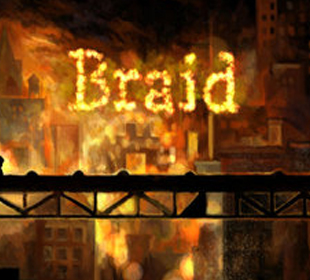RATING: 5 Keys RESULT: Win REMAINING: N/A
A cat may have nine lives, but what if you were allowed to have infinite?
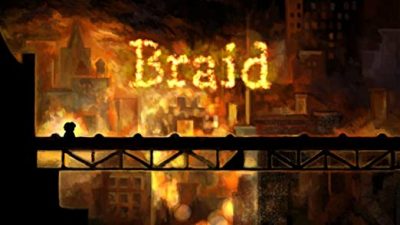


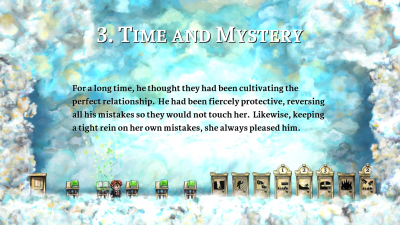
Braid is a puzzle-platformer, drawn in a painterly style, where you can manipulate the flow of time in strange and unusual ways. From a house in the city, journey to a series of worlds and solve puzzles to rescue an abducted princess.
Braid follows the character Tim’s quest to find the princess. It may sound cliché, but the story plays out to have a much deeper meaning than the first impression.
Johnathan Blow, the creator of Braid, has never quite revealed the true meaning of the story as he wants it to be up for interpretation. However, as Tim reads books along his journey, it becomes obvious that the story is told in metaphors. Some of the obscure references make us believe that it is about the creation of the atomic bomb, and that is the most popular theory among players of the game.

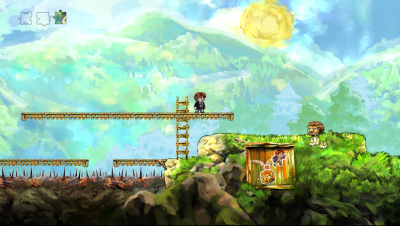 A video game does not need to have fancy 3-D graphics nor state of the art effects in order to still be elegant and aesthetically beautiful. Braid is a prime example of the old adage “less is more”. The careful use of colors elicit an emotionally response from the player in a way not many other games can achieve.
A video game does not need to have fancy 3-D graphics nor state of the art effects in order to still be elegant and aesthetically beautiful. Braid is a prime example of the old adage “less is more”. The careful use of colors elicit an emotionally response from the player in a way not many other games can achieve.
All of the elements in Braid have a “brush stroke” style to them, which gives the game a unique, almost dreamlike feel. The backgrounds are blurred and washed out in order to keep the foreground in sharp focus. Particle effects and subtle movements of clouds create a world that comes alive.
Braid creatively incorporates elements into the landscape as to not appear out of place. Each new world starts with a level that introduces a new mechanic. It would have been easy to simply tell the player “press space bar to jump on the enemy”. Instead, a wood panel in the side of the hill shows the player what to do. This level of detail is consistent throughout the entire experience.
Braid has an excellent sound track and high quality sound effects, so we don’t recommend playing it in silence. Everything from the background music to the spring noises while jumping on enemies wrap Braid into a complete artistic package.

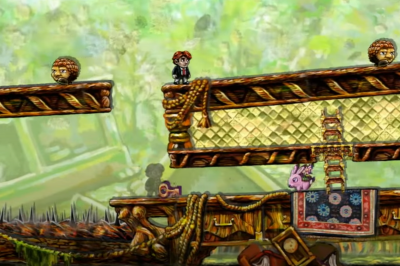 The game mechanics and puzzles are what make Braid shine and create a truly unique experience. While Braid does not truly mimic an escape room like some virtual experiences do, we believe that anyone who enjoys escape rooms will be pleasantly surprised with the abundance of “ah ha!” moments and ingenious puzzle design.
The game mechanics and puzzles are what make Braid shine and create a truly unique experience. While Braid does not truly mimic an escape room like some virtual experiences do, we believe that anyone who enjoys escape rooms will be pleasantly surprised with the abundance of “ah ha!” moments and ingenious puzzle design.
Braid consists of six worlds and thirty-eight levels. Each world introduces the player to a new game mechanic which will be used throughout that world. The pacing of the game is hard to criticize. New mechanics are taught in a tutorial like fashion, and each level becomes progressively harder with some easy wins along the way.
The main objective of Braid is to collect all of the puzzle pieces. Most of them are in plain sight, but many are not easy to reach. There is nothing more satisfying than solving a challenge that initially feels unsolvable, and Braid has many of these gratifying moments.
In World 2 (yes, we start with world 2) the player learns the most basic mechanics used in the rest of the game. Time can be reversed at any point and bouncing on enemies is critical to reaching places up high. Since time can be reversed, the player can never truly die in Braid.
World 3 increases the difficulty a bit by introducing glowing green items to the game. There are keys, levers, and other objects that glow green, and these stay fixed in time even when Tim is going backwards in time. It requires a different style of thinking than most games we have previously played.
In world 4, when Tim moves right, time happily moves forward. However, time reverses when he walks left. Wouldn’t it be interesting if real-life worked like this? This mechanic is completely different than the ones seen in the previous worlds, so a whole new thought process must be used.
In our opinion, World 5 has some of the most difficult challenges. In this world, rewinding time causes a “shadow” of Tim to appear and perform the actions that were rewound. It is required to consider the past, present, and future. Look at us being all philosophical.
The ring… my precious… is introduced in World 6. The ring has a radius around it where anything (including Tim) will make time move substantially slower than elements outside the radius. Many of the challenges ahead in this world are, well, quite challenging.
The puzzles do not stop at World 6, but there are some parts of the story we do not want to spoil. However, we did say “the main objective of Braid is to collect all of the puzzle pieces” for a reason. There is a completely optional side-quest to collect eight stars throughout the game. As challenging as the main game is, it is completely doable without outside guidance. However, truth be told, we had to look up how to collect some of the stars, and we would be very surprised if someone were able to find all of them without outside help. Did we hear challenge accepted?

While rewinding time is not completely unique, we have not seen other games utilize it in the way Braid does. Each world introduces a different time warping mechanic, so the game always stays fresh with plenty of variety. There are many rewarding moments as the player finds their way through several multi-layered puzzles. The art direction and music used throughout add an extra layer to the already stellar mechanics.
Braid is a game for the history books. The creator, Johnathan Blow, has designed one of the most successful indie games of all time, and it is not hard to see why. It was his goal to “bring together the abstract parts of a complex puzzle”, and he has certainly succeeded in creating puzzles with many layers that are satisfying to solve.
Show your support for Escape Authority and get social with us:

Venue: Number None
Location: Home Game
Number of Games: 2
GAME SPECIFIC INFORMATION:
Duration: 4-6 Hours
Capacity: 1 Person
Cost: $14.99 per person











